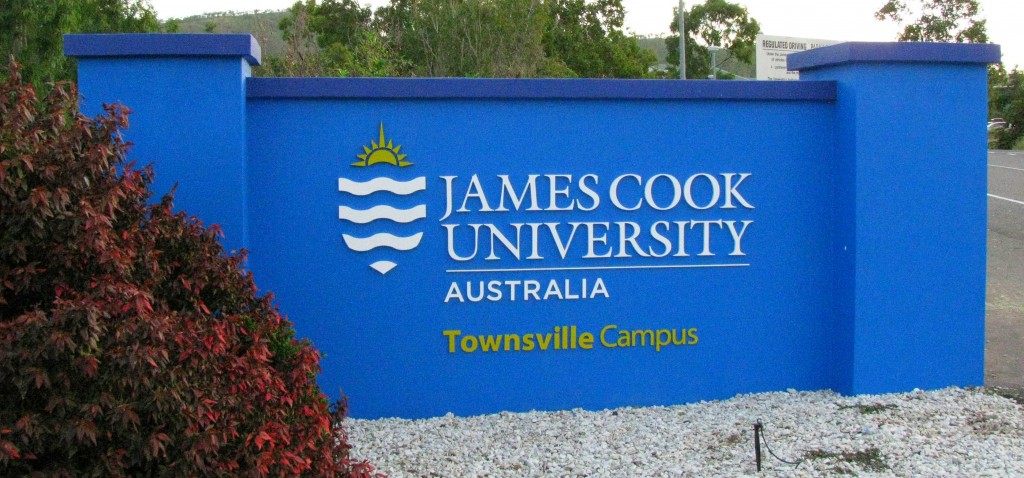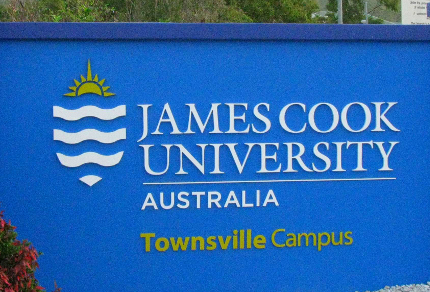
Welcome Sign at James Cook University, Townsville (© Magi Nams)
In the breezy heat of a Townsville spring mid-afternoon, I cycled to James Cook University to attend a university-wide 3-minute research presentation competition. This event was the kick-off for a month of activities aimed at highlighting the talents of the tropical university’s researchers and celebrating their many, diverse research projects. As in the semi-final competition Vilis and I attended three weeks ago, competitors were featured in three categories – established career researcher, early career researcher, and higher degree (Ph.D.) research student. Each competitor had three minutes to tell the judges and audience the ‘what, why, how, results, and so what?’ of his or her research in clear, non-specific scientific language (this last requirement shot down at least one of the competitors).
In contrast to the semi-final event, five established career researchers presented first, their topics ranging from using school children’s art and stories about the environment as a tool for redesigning teaching programs, to repairing tropical wetlands through the use of fire and grazing, to designing traps to detect viruses carried by mosquitoes, to using algae to process carbon dioxide and waste water into economically valuable products, to an investigation of kinship using complexity theory (this last presentation was far too complex for me to discern any relationships to anything). Rocky de Nys took home the Established Career Researcher Award for his work with sequestering the greenhouse gas carbon dioxide through the use of algae.
A half-dozen early career researchers followed, their research projects covering a wide swathe of subjects: using southern cassowary scats to monitor cassowary populations and rainforest health; testing whether parasitic hookworms suppress inflammatory bowel disease; discovering that queen and worker honeybees with the same DNA code assume roles based on the foods they eat as larvae; determining the factors that make a great virtual salesperson; investigating the role of DNA in influencing how corals interact with changing environments; and forecasting the spatial distribution of aftershocks as a means of decreasing damage and loss of life due to earthquakes. Most of these competitors included humour in their presentations. A couple of them talked down to the audience. One (the honeybee researcher, Dr. Sylvain Foret) captivated us from start to finish with the flirtatious simplicity of his presentation, which won the People’s Choice Award. Simon Richards, the earthquake aftershock predictor, earned the Early Career Researcher Award for his presentation.
Another eclectic batch of presentations followed in the student research category, with the six competitors dealing with topics drawn from the fields of tropical medicine (dealing with allergic responses to drugs used to treat recurring hookworm infections), education (designing teaching strategies to maximize educational benefits to highly mobile indigenous students), resource economics (the value of seasonal weather forecasts for North Queensland sugar farmers), and ecology (effects of climate change on the dependence of butterfly fish on table corals; climate change and bird habitat availability; the use of reef and mangrove habitats by black-tip reef sharks). I detected greater hints of nervousness displayed by these competitors, with the absolute exception of John Osborne, who gave a commanding presentation on his topic of the economic value of seasonal climate forecasts for farmers. Osborne won both the High Degree Research Student Award and the Overall Award for the entire competition (perhaps a surprise to more established researchers, but his presentation was strikingly clear, informative, and authoritative). He’ll go on to represent JCU at a 3-minute research competition involving high level student researchers from across Australia, New Zealand, and oceanic islands.
After I returned home, it occurred to me that all of the winners of the three research categories had presented topics dealing with applied science, whether it be the link between meteorology and farming, that between aftershock prediction and earthquake damage, or the multi-pronged connections involving algae, waste water, greenhouse gas carbon dioxide, and valuable eonomic products such as biofuels, food products, and fertilizers. Those topics, however, were not necessarily the ones that stayed in my mind throughout the competition, which streamed from one subject to the next, leaving some presenters shining in my memory and casting others onto a forgotten tide.


